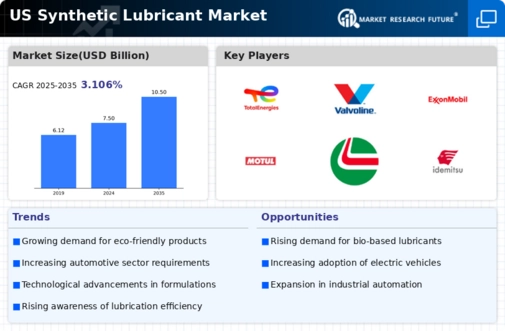The synthetic lubricant market is characterized by a dynamic competitive landscape, driven by innovation, sustainability, and technological advancements. Major players such as ExxonMobil (US), Chevron (US), and Valvoline (US) are actively shaping the market through strategic initiatives aimed at enhancing their product offerings and operational efficiencies. ExxonMobil (US) has positioned itself as a leader in synthetic lubricant technology, focusing on high-performance products that cater to both automotive and industrial applications. Meanwhile, Chevron (US) emphasizes sustainability in its operations, investing in eco-friendly formulations and production processes that align with global environmental standards. Valvoline (US), on the other hand, is leveraging its strong brand presence to expand its market share through targeted marketing and distribution strategies, particularly in the automotive sector.
The business tactics employed by these companies reflect a concerted effort to optimize supply chains and localize manufacturing. The market structure appears moderately fragmented, with a mix of established players and emerging companies vying for market share. This fragmentation allows for competitive pricing strategies, yet the influence of key players remains substantial, as they set industry standards and drive innovation.
In November 2025, Chevron (US) announced a partnership with a leading technology firm to develop advanced synthetic lubricants that utilize AI for enhanced performance monitoring. This strategic move is likely to position Chevron at the forefront of technological integration within the lubricant sector, potentially leading to improved product reliability and customer satisfaction. The collaboration underscores the growing importance of digital solutions in the industry.
In October 2025, ExxonMobil (US) launched a new line of synthetic lubricants specifically designed for electric vehicles (EVs). This initiative not only reflects the company's commitment to innovation but also addresses the increasing demand for specialized products in the rapidly evolving EV market. By diversifying its product portfolio, ExxonMobil aims to capture a significant share of this emerging segment, which is expected to grow substantially in the coming years.
In September 2025, Valvoline (US) expanded its manufacturing capabilities by opening a new facility dedicated to producing high-performance synthetic lubricants. This expansion is indicative of Valvoline's strategy to enhance its production capacity and meet the rising demand for premium lubricants. The facility is expected to improve supply chain efficiency and reduce lead times, thereby strengthening Valvoline's competitive position in the market.
As of December 2025, the synthetic lubricant market is witnessing trends that emphasize digitalization, sustainability, and the integration of AI technologies. Strategic alliances among key players are increasingly shaping the competitive landscape, fostering innovation and collaboration. The shift from price-based competition to a focus on technological advancements and supply chain reliability is becoming evident. Companies that prioritize innovation and sustainability are likely to differentiate themselves in this evolving market, paving the way for future growth and success.




















Leave a Comment